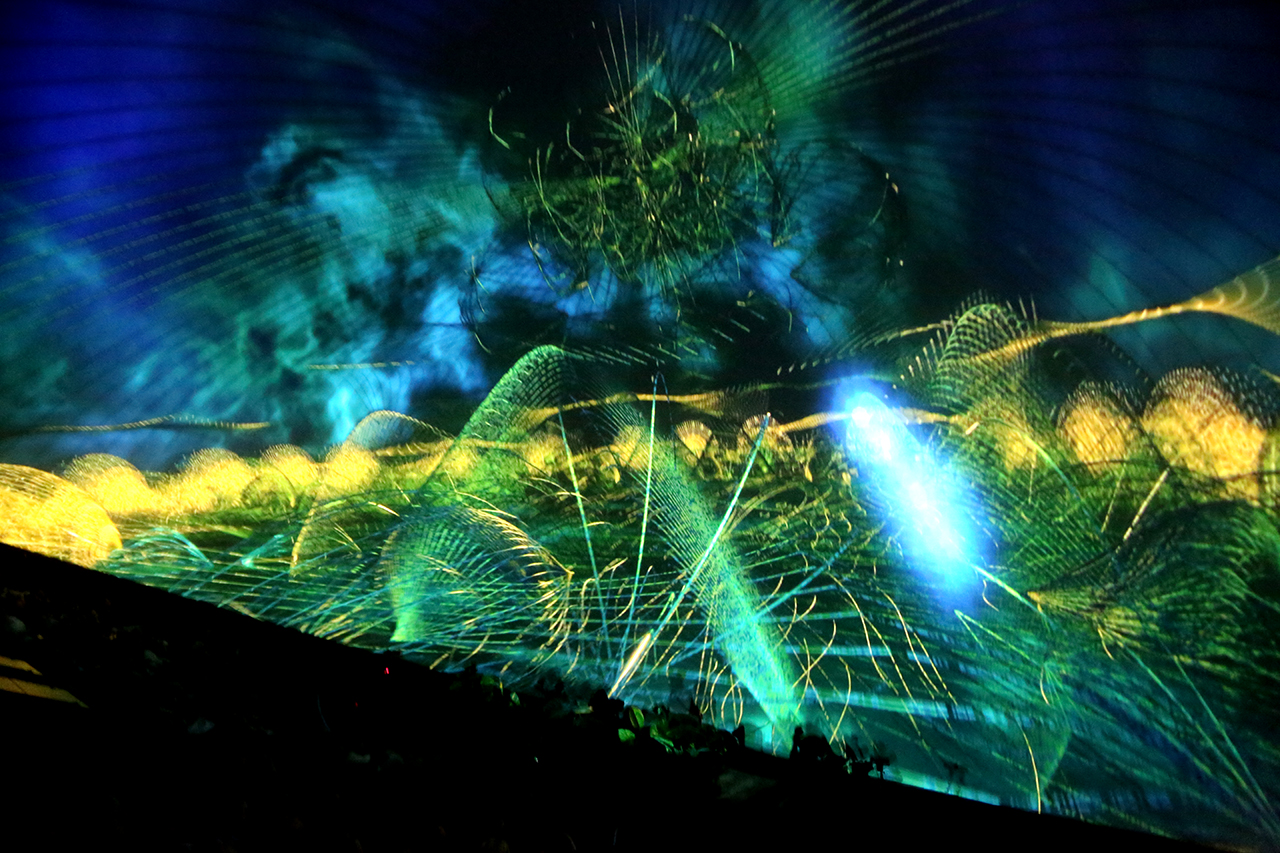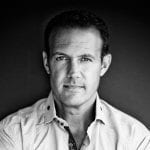
Ed Lantz and Mark Laisure, from the team at Vortex Immersion Media, join OWC RADiO host Cirina Catania. They share their experience working with Dr. Jancy McPhee, and Larry O’Connor of OWC, to help bring the Humans in Space Art Competition to the world.
Go under the hood with Vortex Immersion Media as Ed and Mark explain how they have created next-generation immersive entertainment journeys with a focus on more profound and meaningful experiences with positive social impact. Their ever-popular “Mesmerica” immersive visual and musical journey features the music of James Hood and has been playing to sold-out audiences since its inception.

Ed Lantz is the Founder, President and CTO, Vortex Immersion Media, an entertainment technology engineer and immersive experience designer. He designs 360 digital dome venues and produces and directs those experiences.

Joining him is Mark Laisure, the CEO of Vortex Immersion Media. He is one of the world’s leading designers of transformative 360 immersive entertainment and an inspirational speaker, producer, and C0-Host of The Life Changes Radio Show and Live Event Series. Mark focuses on sharing and embracing “change” to “do life better.”
In this interview, you will learn how Vortex collaborated with Jancy and Larry O’Connor to create the Humans in Space Arts awards ceremony. This unique event enabled guests to share an immersive experience that was indeed out of this world.
In This Episode
- 00:40 – Cirina introduces Ed Lantz, the Founder, President and CTO of Vortex Immersion Media, and Mark Laisure, the CEO of Vortex Immersion Media.
- 04:27 – Ed talks about the Humans in Space Art Celebration event.
- 10:16 – Mark points out how Jancy McPhee, the executive director of SciArt, made the Humans in Space Art event happen.
- 15:40 – Mark shares the interests and vision that him and Ed both share since the day they started working together at Vortex.
- 21:10 – Visit vortexdomes.com to check out Vortex’s transformative 360º immersive entertainment experiences.
Transcript
OWC Radio is sponsored by Other World Computing, delivering perfectly tailored workflow solutions for every tech user with trusted storage, connectivity software, and expansion products and 24 seven us base technical support. OWC believes in making a better world where technology inspires imagination, and everything is possible. Find your solution at macsales.com.
This is Cirina Catania with OWC Radio. We are part of the Vortex team with me today. We’ve got Ed Lantz, who is the founder, president, and the CTO and Mark Laisure, who is the CEO. Now, Ed Lantz is an entertainment technology engineer and immersive experience designer. He designs the digital dome venues and produces and directs these 360 experiences. And we’re going to talk a little bit more about what the dome is. And Mark, you are the CEO, and I was sleuthing around about you, and you have another life. You’re an inspirational speaker and a producer, and you co-host The Life Changes Show. I just think it’s wonderful that both of you are such positive, caring people in an industry that can sometimes be tough. And I was actually watching some of the exit interviews with people that had seen Mesmerica, and they were talking about how much it just changed their lives. So let’s talk for a minute though, and this is part one for those listening in, this is part one of a two-part interview with Vortex, and I want to start out by talking about how we all met through OWC and the Humans in Space Art Celebration. Vortex was one of the major sponsors as well as OWC, so can you guys tell us how you met Larry O’Connor and the folks OWC?
ML: Absolutely. I wanted to follow up on that question. We’ve been very excited about this relationship that’s growing with OWC and with the SciArt team. [Satori Pon], who has been working with OWC, actually is a longtime friend of mine and friend of Vortex. And it was her brainchild not only to introduce OWC and Vortex for possible alliance and product partnership for what OWC does and to support Vortex expansion needs as we’re now building and rolling out a global network of these immersive 360 domes. But then also the opportunity came up to support the Humans in Space SciArt events, sponsored by OWC and Vortex to really be able to kind of prove a little bit of what we do, showcase the power of this format, support children’s education, and science and creativity. And it really was kind of the perfect storm of things coming together in a positive way for us all to be able to collaborate for good, for the right cause and showcase a little bit of what we do in what we can do together.
Well, I know that Larry O’Connor was very excited about it because it was right on the heels of the 50th anniversary of the Apollo 11 moon landing. So everything kind of came together. I think we’re all techies, but we’re also all wonderful fans of whatever happens in space. So what exactly is the SciArt Exchange, and what are the Humans in Space Art Celebration for people who don’t know about it?
ML: Well, it’s a research and creative entertainment platform. That is helping to engage the creative minds of students, and of our younger audience and really start to be able to inspire the thought and creativity of children around the world but also from awareness and analysis and learning of space and spatial relations and kind of re-inspiring an exploration of our Cosmos from the global perspective from children all over the world.
I think it’s wonderful. Since this is a radio and we’re not showing people pictures right now, there will be a print part of this as well. But for right now we’re radio, can you talk to us about what the dome looked like? Who was in the room, and what happened that night?
EL: Yeah, I’m happy to address that here. It was an award ceremony. And it was an immersive award ceremony. So we actually surrounded the audience with visuals, and the different presenters would come up, and we got to see clips from the students or the kids’ work upon the dome. We also wrote it, and we had some fun. We also ran some immersive content, one of which is monsters of the galaxy, which features Neil deGrasse Tyson and some of the other scientists talking about Black Holes, but it’s actually a music video that sort of riffs on the concept of Black Holes and how the center of the galaxy there could even be millions of it the galaxy for all we know, and it’s a musical presentation like that. So the dome really is the epitome of SciArt. The planetariums are where this format was born. And planetariums had domes because they wanted to visualize the night sky, and the celestial sphere is spherical. So back in 1923, Carl Zeiss invented the planetarium projector, put it in the dome and voila, you have the accurate astronomical simulation of the night sky. So now we’re projecting pixels on the dome. So it’s kind of like putting a virtual reality headset onto a large group of people at the same time.
So just to make it clear, they’re not wearing headsets, they’re experiencing the spherical dome all around them while they’re watching and listening, right?
EL: Exactly. A lot of people come into the dome, and they’ll say, “Gosh, I can’t wear those headsets, they hurt my eyes,” or whatever, but this is simple. You just walk in the door and look around. It’s really just a movie screen that wraps around your head. But because it’s digital now, the dome actually becomes a portal into cyberspace, into 3D data sets of astronomical information that we now visualize and can fly people through.
You’re in Hollywood, the domes are on top of the Beaudry building in Hollywood, right?
ML: Yes, we’re in downtown Los Angeles. And we’ve been there for nearly ten years now. We’re the first and just about the only immersive media studio in Los Angeles that is doing 360 dome productions. So this is cutting edge, it’s an emerging format. We’re taking the domes from the planetarium market, which are science centers, museums, and like that. Also, there are IMAX domes that make documentary projections. We’re bringing now the format into mainstream arts and entertainment.
I love the combination of music and art. Can you describe the look on these kids’ faces when they first walked in? How many children were there, and how old were they?
EL: Well, we had a full house standing room only. I couldn’t tell you the age ranges, but there were some quite young kids, I guess you might say K-12. And it was an awesome event, and the kids loved it. And we had a stage set up and stage lights, and they got to receive their awards on the stage, and there were really some fun presentations too, musical and whatnot. So it was a great event.
ML: The kids love it, but I have to say, adults, when they go into that dome, they almost turn into kids. There’s just a sense of wonder and awe when the sky above you changes in real-time.
Isn’t that the whole core of creativity is finding the child and the innocence within us and just following that path? But I think this is such a beautiful marriage of young people who have these open hearts and open minds and this incredible creativity, and then also inspiring the adults in the room. It sounds awesome. I wish I could have been there. I wasn’t there that night, and I really regret that I couldn’t have been there. I think the kids were about, from what I understand, were between the ages of 10 and 18. That’s a pretty wide range. So you had Blake Lewis hosting that night?
ML: Oh, Blake is awesome. And he recorded his voice and made sounds, and then he actually got some of the kids up there to record their voices, and he was like, protecting an orchestra. He made music out of it.
EL: Quite fun.
Oh, that’s wonderful. That’s awesome. These kids are never gonna forget this, aren’t they? I’m looking at the list. Also, you had Raj Sareen, a NASA scientist, and Alan Chin, a contemporary artist. And then I’m going through the list here, National Geographic Mars’ writer and producer Mickey Fisher. What an incredible group of people and the look on Larry O’Connor’s face when he was on the stage because you know he loves space.
EL: He was definitely one of those big kids that we were talking about. It was so enjoyable to watch him, and all the kids really kind of get inspired and connect. And that’s the great thing about being in that dome environment is you’re able to share the experience and connect, and everybody’s taking that journey together.
So do you know Jancy McPhee?
ML: Oh, yeah. Jancy was the executive director of the Humans in Space and SciArt Exchange. She drove the whole event, I mean, she was really the producer. We were in service to her, actually. So, she gave us the credits, and we put them on slides and mix them up with some immersive visuals. She also had help on creating a piece of feature the kids content on the dome, so it was actually rendered in spherical format. So yeah, Jancy made it happen.
That’s wonderful. Well, I hope to interview her about all of this. Maybe we’ll get her on and get her to take on all of this. I’m looking at a visual, and it’s just actually the drawing of the dome. So how many people can sit here? It looks like 130 seats something like that?
ML: That’s right, and they were standing remotely. So it was a full house.
And so Ed, you direct these live presentations, were you directing this one as well. I know you do the Vortex, the ones like Mesmerica, which we’ll talk about in part two of this interview, but were you directing that night as well?
EL: So we have a team, and I was working alongside Caitlin Holtz, who was running video and lighting. And so I was, behind the control console, we also had Donovan working with lights. So it takes a team to make this happen. I did produce the visuals for Jancy, made sure everything came in the right formats, and at the last minute, were downloading multi-gigabyte files. So these things could get a little stressful sometimes, but my job is to make sure it all happens smoothly, and I think Jancy was thrilled with the result.
Can we look under the hood for a second and talk tech, we have a very tech audience that likes to listen in. What was the format for delivery?
EL: Well, we’re displaying 3K by 3K pixel, fisheye frames in the dome. There are systems out there that go up to 8K by 8K. So, this is a format that’s scalable. There’s big domes or small domes or tilted domes like that. Now the frames look like a circle. It’s actually a fisheye frame; it’s called a Dome Master. And it’s a format that I helped to author the Standards for, way back In 2004, we had a FullDome Standards Summit in Valencia, Spain, and locked down this format and now there are 1600+ digital domes around the world using this format. It works great. We’re also now pushing the envelope by doing live programming, which actually most digital planetariums can run a program show, you push a button, and the file plays. We wrap them up into QuickTime files, actually. And most of the work we do is 4K by 4K pixels. It’s a little easier with the 3K frames. Just like a movie, you push play. But when we’re doing a show like this, there’s actually a cue list. And we have one clip after another clip after another clip and slides. And we’re cueing them manually in real-time.
That’s the scary part about live production. Now when you’re editing the clips together, like if you’re presenting a music video, what NLE are you using? Do you know? Or does it vary by the editor?
EL: Yeah, it’s all over the map. Common tools are Premiere Pro and After Effects, actually. But a lot of the work we do is very visual effects heavy. We also use nuke for some of the productions, we have a production right now we’re using Houdini to animate with. And this is what’s really cool all of the tools now like Premiere Pro and After Effects and others have 360 capability built-in. So when we first started doing this in the mid-90s, we had to write our own plugins. You have to do the spherical rendering for compositing, and then you might project onto the sphere and then want to rotate it later. So now, with VR, the 360 cameras have advanced, the software has advanced, and it’s awesome. And the same with the memory. We’re using an array of SSDs to playback the content to get speed up. So, when you start pushing 4K by 4K frames at 60 frames a second, data rates tend to get a little high.
No kidding. I was gonna ask you if you used any OWC products for that, and the SSDs are pretty good.
EL: Yep, they’re the best, and that’s what we use. For sure.
I’m just curious. Mark, how long have you known Ed?
ML: Well, it seems like lifetimes, but which is why I appreciated the way you’ve initiated the discussion because there’s so much commonality. But I’ve been with Vortex overall for about two years now. And yet, we were introduced, I was actually at the grand opening of the Vortex dome, and we didn’t even meet at that time, and then I was reintroduced many years later and then reintroduced again when the opportunity to come together will present itself. So the combined path that we were both on was to really use experience and content in a meaningful socially impactful and positive manner. And I was working with the award-winning VFX team, and we are looking at immersive productions and there there were no summit permanent or permanent arts and entertainment domes, and then I had the opportunity to meet Ed and see the history of Vortex having pioneered this space from a digital projection perspective and the opportunity to come in support the team and expanding our footprint and beginning to roll out what we call is an Immersive Intelligence Network of experience centers around the globe presented itself.
It had to be incredible to be in that room that night of the award ceremony and watch future scientists and future artists really be rewarded for what is native to them. A lot of creative people are always told, go out, and get a real job. And I was so excited to hear from you because I think what you’re doing is so important. Music art, the entertainment field is so critical to success in all forms of life. I mean, music can heal, if you have a brain injury, as a lot of our troops do, and they come back from the war, music really can help heal the brain. I’m encouraging people to go and learn a little bit more about you. Where can they go to see what you did with the SciArt challenge? Is that on the SciArt exchange website?
ML: Yes, and then, of course, vorteximmersion.com, to learn more about the domes. I would love to comment on something you just met, because to me, I studied engineering and have a master’s in EE. And I’m one of the few engineers who got through the system which was half hardest, right? And I’ll tell you what, it gave me a real edge in the business because my first job out of school was aerospace engineering. And I worked alongside 3000 other engineers at Harris Corp., and engineers tend to think very black and white, and I was able to come into very challenging situations and make intuitive leaps that just baffled the engineers. And I’ll tell you, it’s like the young people tend to get filtered out if they are not good at math. And I tell you, we’re all about promoting STEM, Science, Technology, Engineering, and Math. But I think it’s also the worst thing you can do is tell a kid, “hey, you need to study math and science, technology and engineering.” Ask them if they want to build a rocket ship. Ask them if they want to fix climate change. Because it’s like the impulse to innovate and create is the thing that really led me not the desire to play around with mathematical formulas. Math was just the language, the tool that I use to do the things that I do.

I know that my engineering friends and I like to get together every few months and solve the problems of the world. We can sit around for hours and just talk about or make things up even and say, Okay, what are we going to do to make this better and it’s pretty amazing. I’m not an engineer, but I do admire that kind of mind. Luckily, I do have the left and right side going, Mark. I think you do too, and I wish Kate were on. It’s a shout out to Kate because she’s very involved in all of this, Kate McCallum, and hopefully, we’ll be able to get her for part two of this interview. That would be awesome. Is there anything else that you want to say that I might not have covered?
EL: Aside from the fact that we’re thrilled, not only to have had the experience with the SciArt Exchange and the Humans of Space event, but the relationship with OWC is one that’s very exciting. Everybody has been spectacular. Clearly, Larry has built a wonderful culture of not only expertise technologically but just good humans. It’s a really great group of people. And we’re really excited about what’s evolving there.
ML: Yep. And our vision is to build these domes all over the world and center dome grid, which are servers that can serve out this massively huge frame of content. So that becomes a resource that all of the domes can draw on. So we’re going to eat lots of memories.
Yeah. There you go. And I can’t think of a better memory than the memory you get at OWC. Oh, that’s wonderful. I’m so proud of both of you. And thanks for spending time with us. And I do encourage everyone to check out the SciArt Exchange. It’s a nonprofit that works to change the world by bringing science and technology together with art. I really do encourage you, and I’m going to try to find out who the winners are. And maybe we could get one of these young children on OWC Radio as well be nice to hear firsthand. But in the meantime, where do you want people to go to learn more about the two of you?
EL: vortexdomes.com or they can also arrive at the same landing at vorteximmersion.com. You’re going to be hearing more and more about Vortex Immersion and the Immersion Domes. And the one last thing I’d say about this shared experience is that it’s the missing link when you look at VR, in that you can have the communities sharing experience and then you can interconnect out to VR and start to have a globally shared experience unlike we were ever able to have entertainment.
Well, I think both of you very much, and I encourage everyone to go check this out and stay tuned for part two coming shortly. We’ll be interviewing the Vortex Immersion media team, Ed Lantz, Mark Laisure, and hopefully, Kate McCallum can join us. She’s tied up on the road at the moment, but we’re going to keep texting her to see if we can get her on. Thank you, everyone, for listening and remember what I always tell you get up off your chair and go do something wonderful today. Take care. Have a great day.
Important Links
- Other World Computing
- Ed Lantz
- Mark Laisure
- Vortex Immersion Media
- SciArt Exchange
- 50th anniversary of the Apollo 11 moon landing.
- After Effects
- Alan Chin
- Blake Lewis
- Carl Zeiss
- Dome Master
- FullDome Standards Summit
- Harris Corp
- Humans in Space Art
- Celebration
- Jancy McPhee
- Kate McCallum
- Larry O’Connor
- Mars
- Mesmerica
- Mickey Fisher
- National Geographic
- Neil deGrasse Tyson
- Premiere Pro
- QuickTime
- Raj Sareen
- The Life Changes Show
Checklist
- Train your mind to be more creative and innovative. It’s not a gift that you’re born with, it’s a skill you can improve over time.
- Incorporate an immersive experience into your art. Get your audience to interact with your work so they may remember the experience even after the show.
- Encourage children to learn more about SciArt. Education should not just focus on STEM, it’s beneficial to a child’s brain development to elevate and nurture their artistic abilities.
- Create events/workshops that promote fun in STEAM education. Collaborate with children and open a world of possibilities for them through art and learning.
- Check out Vortex Domes’ website to learn more about immersive intelligence.